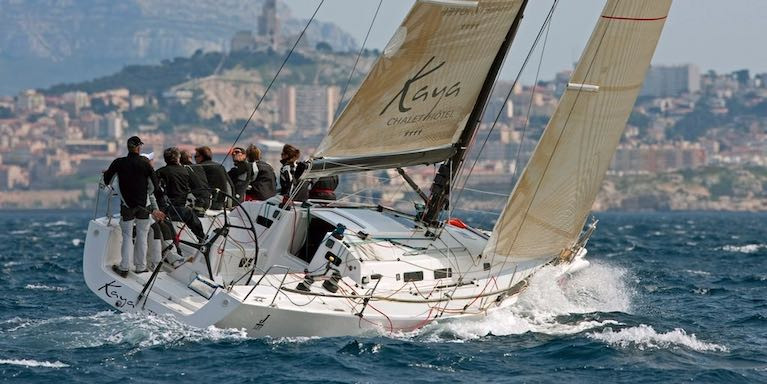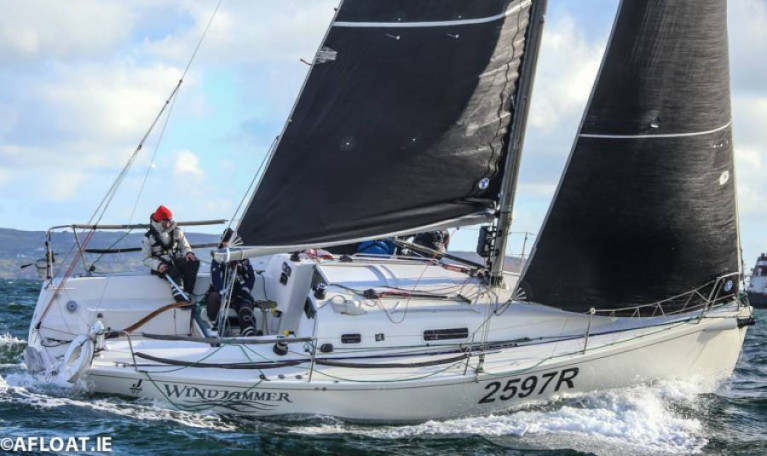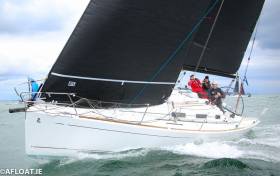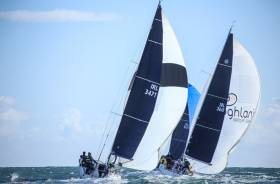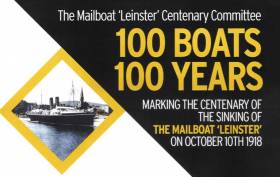Displaying items by tag: kish race
DMYC Kish Race on Dublin Bay is Postponed Due to COVID
The DMYC Kish Race on Dublin Bay that has attracted 51 entries for this Sunday morning's start off Dun Laoghaire Harbour has been postponed due to the Level 3 COVID restrictions coming into effect at midnight.
The annual fixture has assembled a sizeable fleet including yachts from nearby Greystones Harbour in County Wicklow.
DMYC race organisers hope to reschedule the race and plan to advise competitors early next week.
Greystones Harbour Boats to Boost DMYC Kish Race Entry on Sunday
Up to six County Wicklow boats will travel from Greystones Harbour early on Sunday morning to compete in the DMYC Kish Race swelling the already buoyant 40-boat entry for the annual Dublin Bay Race.
The Greystones visitors include the latest entry Frank Whelan's new J122 Grand Prix, Kaya, that will make its Irish race debut at the Dun Laoghaire Harbour event.
Whelan's new yacht is a sister ship to the well-known Royal St. George J122 Aurelia, a top Irish offshore performer.
Kaya is a replacement for Whelan's all beating Eleuthera, a Grand Soleil 44, that has been sold to new owners in Cascais, Portugal.
Kaya arrived in Ireland just a fortnight ago from France, so she is still in shakedown mode, according to her skipper for the Kish Lighthouse Race, Paddy Barnwell.
A new entry is Paul Barrington's well-known J109 "Jalapeno" from the National Yacht Club that will also be a serious contender for line and class honours in this year's race.
As Afloat previously reported, the race takes place from the DBSC Hut area at the back of the West Pier, starting at 10.30 am on Sunday.
The race has already attracted an entry of over 40 boats and promises to offer some impressive "head to heads" amongst the various competitors. The recent access of George Miller in "The Den" is no doubt welcomed by his Shipman classmates.
In the Ruffian 23s, David Meek and NYC Commodore Martin McCarthy are also racing out to the lighthouse.
Race Officer (RO) Larry Power is hoping for fair winds for the race. Currently forecast is for 10 to 16 knots from the East with the possibility of some sunshine.
The RO has the option to set an Inflatable Mark that will not be quite as far as the Kish if the feeling is that the wind is not sufficient.
Due to demand, The DMYC have extended the Entry Cut Off to 1900hrs on Saturday 19th. You can enter here.
Sailing Instructions are downloadable below.
The current entry is below:
CURRENT KISH RACE ENTRY LIST 2020


Dublin Bay DMYC Kish Race Hots Up With 35 Entries & Counting for Sunday's Start
With entries close to 35 boats, the annual DMYC Kish Race has been made all the more interesting with some of top ISORA boats now entered for this Sunday's Race on Dublin Bay.
ISORA coastal regulars such as the Royal Irish's new Prima Forte, a Beneteau First 40, plus the Royal St. George's J97 Windjammer, the National Yacht Club's Sunfast 3600 and the Dun Laoghaire Marina based First 310, More Mischief are all now entered.
The organisers have acceded to a request from Cruiser 3 Class Captain, Kevin Byrne, that the results from the race be used for part of the Cruiser 3 Annual Championships which also takes place this week.
 The Grzegorz Kalinecki skippered First 310, More Mischief
The Grzegorz Kalinecki skippered First 310, More Mischief
The Cruiser 3 Class will use a combination of their Saturday DBSC results and the Kish Race results to decide the 2020 Champion.
The Committee is also very grateful to Larry Power (NYC) who kindly agreed to be PRO assisted by regular Club Stalwarts, Brian Mulkeen and Rodney Beste. The Race begins at 1030 hrs from the normal DBSC "HUT" starting area, and the Finish will be between the East and West Pier Lighthouses (for any spectators with an Interest!).
In a change from last year's format, the Committee has elected to have three separate starts, One for Cruisers 0/1; another for Cruisers 2/3 and Shipmans and finally a start for Cruisers 5 and Ruffians.
The club has also elected to award Prizes not only to the Overall Winner ( the magnificent "Kish Trophy") but also to the winners of each Cruiser Class, Shipmans and Ruffians.
 John O'Gorman's Sunfast 3600 'Hot Cookie' from the National Yacht Club
John O'Gorman's Sunfast 3600 'Hot Cookie' from the National Yacht Club
John O'Gorman's "Hot Cookie" will no doubt cut a dash in Cruiser 0/1 along with former DMYC Commodore Leslie Parnell in "Black Velvet" along with "Prima Luce".
No doubt the Ruffians and Shipmans will have battle "Royale" given the List of keen Helms including Gerry Glynn, Brendan Duffy, Michael Cutliffe and many others.
The regular inhabitants of the 55-year-old Kish Lighthouse (Cormorants and Herring Gulls in the main) are in for some disturbance this Sunday!
The DMYC have confirmed that they are extending the Entry Deadline up to 7 pm on Saturday 19th of September. You can enter here
The Kish Race 2020 entrants so far are as follows:


Parnell's First 34.7 'Black Velvet' is DMYC Kish Race Winner
Leslie Parnell's Beneteau First 34.7 'Black Velvet' is the 2019 winner of a shortened DMYC Kish Race on Dublin Bay today, the “last major” in the Bay summer season.
Second was the National Yacht Club J109 Jalapeno (William Despard) with Greystones Champion Eleuthera, a Grand Soleil 44, skippered by Frank Whelan in third.
As Afloat reported earlier, Handicapping was based on ECHO Standard, giving those with revised ECHOs a good chance at the prizes.
Fifty-two boats entered the race this year, and 47 showed up on the start line. Neil Colin, the Race Officer, delayed the start until 1110, to give a few stragglers a chance to get out of the harbour and up to the line.
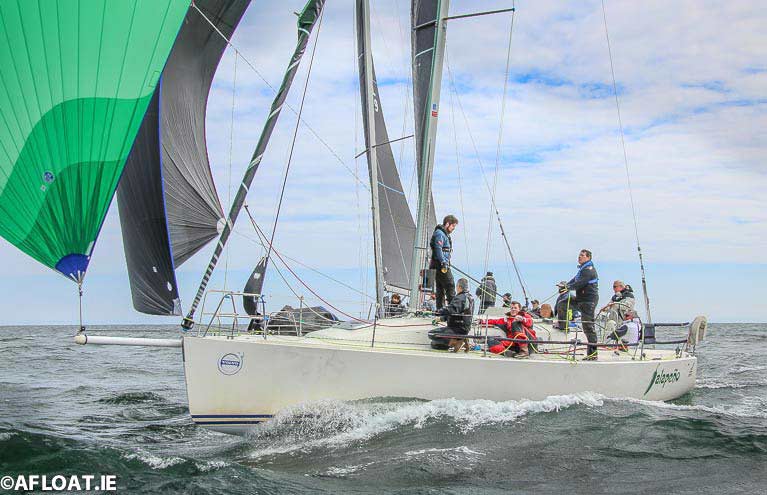 William Despard's J109 Jalapeno was second Photo: Afloat
William Despard's J109 Jalapeno was second Photo: Afloat
 Wicklow visitor Eleuthera was third overall Photo: Afloat
Wicklow visitor Eleuthera was third overall Photo: Afloat
The pin end was favoured by most of the bigger boats, with Aster1x joining in. A flooding tide ensured the start was all clear (by several boat lengths in many cases), and the fleet was away. Well, most of it was away; the last boat cleared the line at 1140 – the flooding tide and a falling wind close to the land was the undoing of several competitors. Those who favoured the pin end, despite a stronger tide, benefited from more of the wind that was sweeping over the Muglins and Dalkey.
After a bit of rain, the wind filled in again, and reigning champion Eleuthera was first around South Burford (the course was shortened due to a forecasted lack of wind) and back just after 1245. The rest of the fleet came home over the next two hours, with the final boat crossing the line at 1520.
Results for the race are here.
Kish Race 2019 First Gun Postponed Til 10.55 on Sunday
While last year it was the threat of a gale warning decreased numbers, this year, it is an unfortunate clash with the opening Irish match at the Rugby World Cup. Accordingly, the DMYC has postponed the first gun to 10.55 this Sunday to allow sailors to see the bulk of the game and still have time to enjoy competing in the Annual DMYC Kish Race.
In the event the breeze is not as strong as last year, the organisers may use a shorter course length, to ensure a good duration of a sail, for the last major race of the year, despite the later start time.
The event is designed to attract recreation and cruiser sailors as well as the regular racing community.
The DMYC looks forward to welcoming all sailors to the prize giving and Après Sail after their voyage.
DMYC Kish Race is 'Last Major Fixture' of Dublin Bay Summer Season
Dun Laoghaire Motor Yacht Club (DMYC) has published the Notice of Race for the 2019 Edition of its annual Kish Race.
The round Kish and back race will take place on Sunday 22nd with the first gun at10.25 a.m.
Starting at the town's West Pier and racing to the Kish and back, it is a distance of approximately 28 km.
As Afloat reported in 2018, the last race saw Hot Cookie (Sunfast 3600 - John O’Gorman) leading to the Kish Lighthouse some 13.9 km out from Dun Laoghaire. An inside overtake at the mark by the bigger Eleuthera (Frank Whelan) saw them lead all the way to the finish. The reward for Hot Cookie (second on the water) was an overall win, on corrected time.
Race organiser Neil Colin says that 'as this is the “last major” in the Dublin Bay summer season before the lift out or winter racing, the club is looking forward to an enthusiastic entry'.
Handicapping will be based on ECHO Standard, giving those with revised ECHOs a good chance at the prizes.
The Notice of Race and entry can be found here
Sunfast 3600 'Hot Cookie' Wins DMYC Kish 'Blaster' as Race Commemorates 100th Anniversary of RMS Leinster Tragedy
Despite the stormy past week and uncertain forecasts, another special day's sailing on Dublin Bay was completed today with the DMYC Kish Race merged into the start of the Leinster 100 Commemoration writes Neil Colin.
The day saw Hot Cookie (Sunfast 3600 - John O’Gorman) leading to the Kish Lighthouse some 13.9 km out from Dun Laoghaire. An inside overtake at the mark by the bigger Eleuthera (Frank Whelan) saw them lead all the way to the finish. The reward for Hot Cookie (second on the water) was an overall win, on corrected time.
Download results as a PDF file below
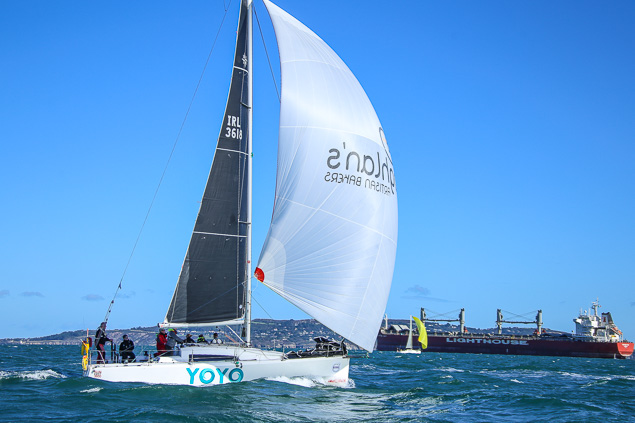 YOYO (Sunfast 3600) Brendan Coughlan (foreground) with sistership and race winner Hot Cookie (lemon spinnaker) passing an appropriately named moored ship on the run out to the Kish Bank Photo: Afloat.ie
YOYO (Sunfast 3600) Brendan Coughlan (foreground) with sistership and race winner Hot Cookie (lemon spinnaker) passing an appropriately named moored ship on the run out to the Kish Bank Photo: Afloat.ie
The 2018 race was another “blaster” this year after the calm conditions of last year, providing a running start, clear blue skies, a steady 15 knots of north-west breeze, gusting to 25 knots and more at times, the leaders reached the single course mark being the Kish Lighthouse in about 50 minutes, and returned to cross the finish line in 1 hour 50 minutes, even faster than the 2016 race elapsed times, and setting new records.
The 2018 race was another “blaster”
 Eleuthera (orange spinnaker) leads the race out to the Kish Photo: Afloat.ie
Eleuthera (orange spinnaker) leads the race out to the Kish Photo: Afloat.ie
The race started with the running start, stolen by Ruffles (Michael Cutliffe) on the pier end, who tracked lower than most, to be later upset by a Northerly shift favouring those on a higher line, who held kites all the way to the turn, while Ruffles had to round close hauled.
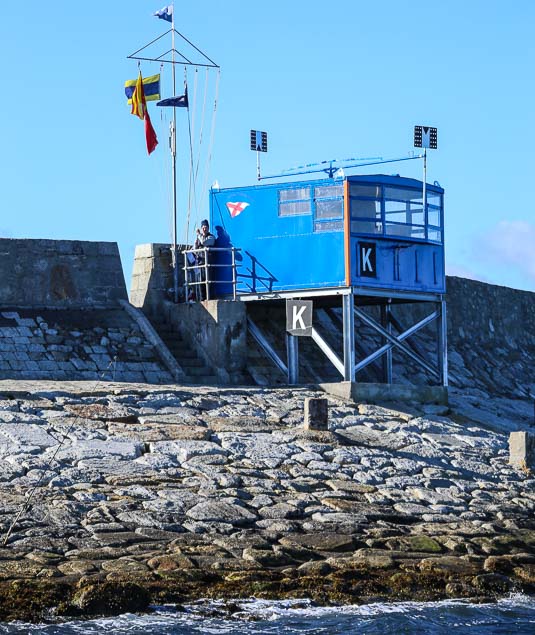 The DMYC burgee flying over the DBSC Hut for the annual Kish Race from the West Pier Photo: Afloat.ie
The DMYC burgee flying over the DBSC Hut for the annual Kish Race from the West Pier Photo: Afloat.ie
The outward leg saw spectacular boat speeds, and indeed several shredded sails were observed by the race organisers in the DBSC West Pier hut.
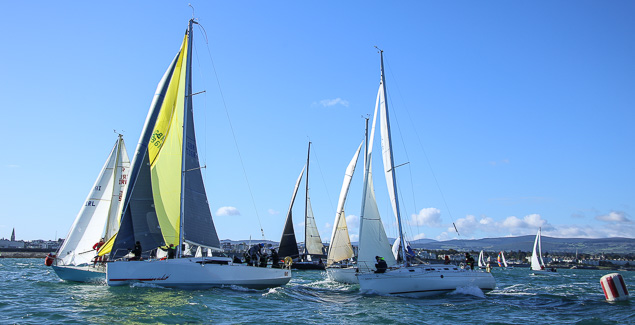 Gun! Hot Cookie (lemon spinnaker) makes her move at the leeward end of the line Photo: Afloat.ie
Gun! Hot Cookie (lemon spinnaker) makes her move at the leeward end of the line Photo: Afloat.ie
At the turn, the competitors (after the manoeuvring and sail changes) each placed a white carnation flower in the water as an act of remembrance to those who perished on the Leinster, almost 100 years ago. A symbolic gesture everyone involved was pleased to support.
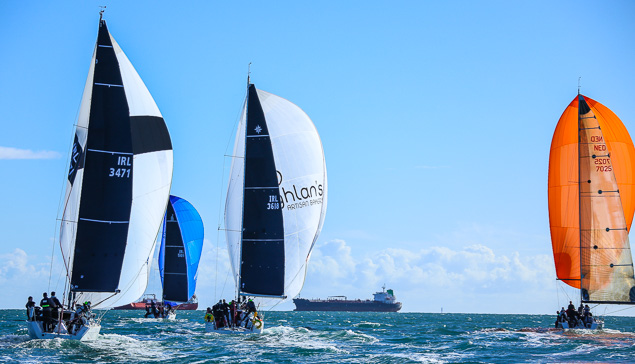 Great conditions for the reach out to the Kish Lighthouse (just visible close to the stern of the right-hand ship) Photo: Afloat.ie
Great conditions for the reach out to the Kish Lighthouse (just visible close to the stern of the right-hand ship) Photo: Afloat.ie
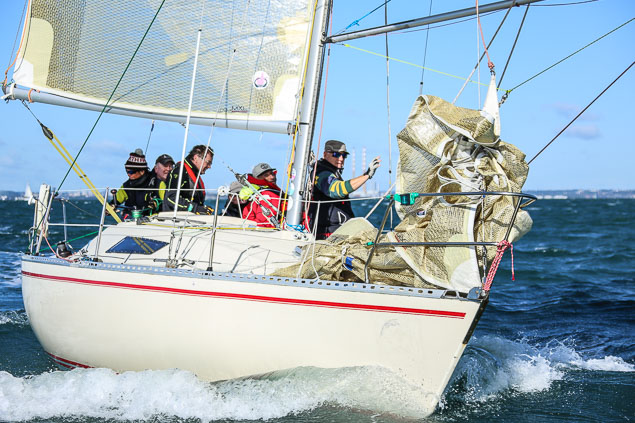 Peter Richardson's Dubious Photo: Afloat.ie
Peter Richardson's Dubious Photo: Afloat.ie
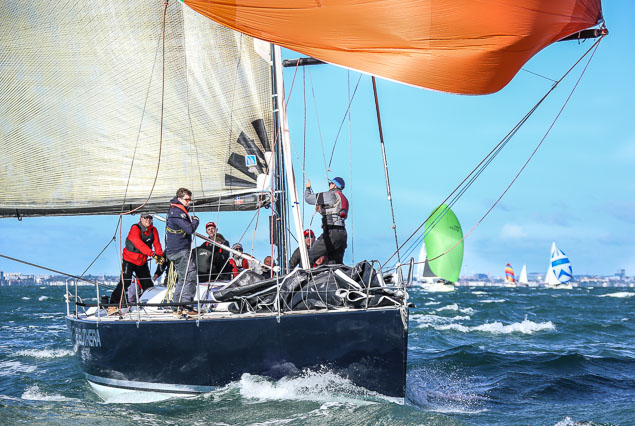 Frank Whelan's Eleuthera Photo: Afloat.ie
Frank Whelan's Eleuthera Photo: Afloat.ie
The return leg was a tougher affair, with several competitors suffering gear failure and more sail damage on the long starboard tack back to the finish line, increasing in difficulty as the ebb tide kicked in against the smaller and slower competitors, sealing their fate on handicap.
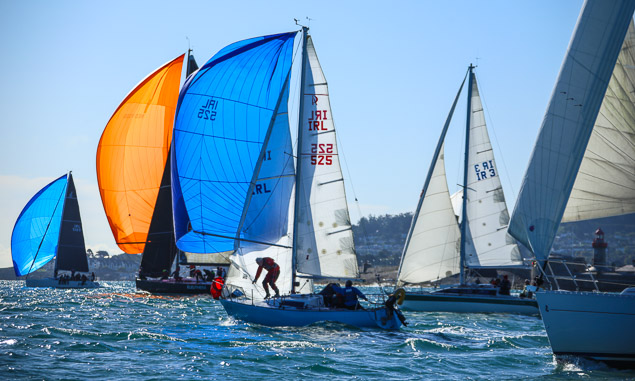 IRL 525 Ruffian Alias (David Meeke & Martin McCarthy) had a standout performance Photo: Afloat.ie
IRL 525 Ruffian Alias (David Meeke & Martin McCarthy) had a standout performance Photo: Afloat.ie
First home was Eleuthera, followed by the winner Hot Cookie, but probably performance of the day was Ruffian Alias (David Meeke & Martin McCarthy) who held the more northerly track to the mark, and the kite all the way there, and then, managed to hold off larger higher handicap yachts on the return leg.
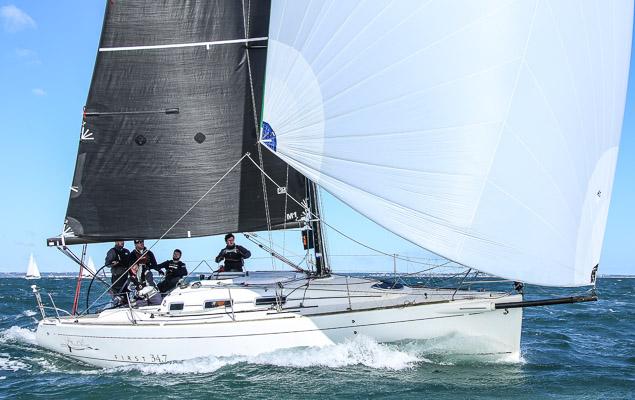 The Beneteau 34.7 Black Velvet sailed by Kevin Brasil Photo: Afloat.ie
The Beneteau 34.7 Black Velvet sailed by Kevin Brasil Photo: Afloat.ie

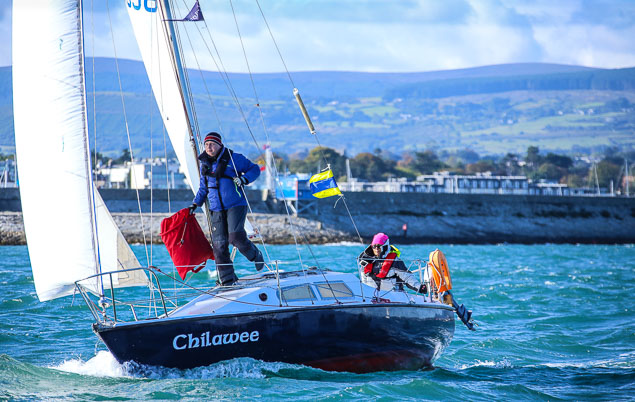 Chilawee Photo: Afloat.ie
Chilawee Photo: Afloat.ie
Also of note, Jalapeno (J109) William Despard, winner in 2016 was third Overall, following a tight battle on the water with YOYO (Sunfast 3600) Brendan Coughlan finishing 4th, and the Beneteau 34.7 Black Velvet sailed by Kevin Brasil and friends were fifth.
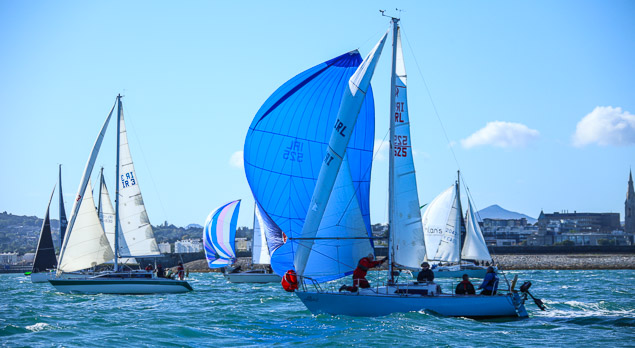 Denis Nolan’s Club Shamrock Emmanuelle (IR 3) among the starters at Dun Laoghaire Photo: Afloat.ie
Denis Nolan’s Club Shamrock Emmanuelle (IR 3) among the starters at Dun Laoghaire Photo: Afloat.ie
The Kish race continues to attract some more cruiser orientated sailors including Joe Csibi’s Wild Goose and Denis Nolan’s Club Shamrock Emmanuelle who acquitted themselves well, in the face of more competitive modern designs.
 Maranda Photo: Afloat.ie
Maranda Photo: Afloat.ie
 J109 Dear Prudence Photo: Afloat.ie
J109 Dear Prudence Photo: Afloat.ie
In addition to the prizes, the Leinster Commemoration organisers presented a book to the prize winners describing the sinking of the Leinster in 1918 and the associated stories, cementing the partnering of the race with the upcoming commemoration.
Download results as a PDF file below
Green Light for Kish Race – DMYC Organisers Report 'Favourable' Weather Conditions for Sunday Start
Holding their nerve in the face of forecast stormy conditions for the weekend, the DMYC in Dun Laoghaire now report the weather conditions now look very favourable (if a bit wet) for the last major event on Dublin Bay this summer, this Sunday’s DMYC Kish Race, starting at approximately 10.30 from Dun Laoghaire's West Pier.
Earlier this week it was feared the event would be cancelled due to gales, a decision made all the more difficult as this year's edition also serves to commemorate the loss of the RMS Leinster near the Kish Bank 100 years ago.
Race organiser Neil Colin told Afloat.ie 'We have added a further detail to the event, in that all entries will be given a White Flower (biodegradable) before going afloat, and asked to take a moment as they round the Kish, and drop the flower in the water, as a memorial to the event almost 100 years ago".
It's a touching thought and a symbolic gesture to those who perished.
The entry system is open on www.DMYC.ie
100 Boats for 100 Years: Commemorating the Centenary of the Sinking of the RMS Leinster
The Dun Laoghaire Motor Yacht Club has announced the 2018 edition of its Kish Lighthouse Race will be known as “100 Boats for 100 Years”, reflecting the forthcoming commemoration of the centenary of the sinking of the RMS Leinster with the loss of 501 lives on Dublin Bay in 1918. More details on that sinking here.
Together with the Dublin Bay Old Gaffers Association, the sailing event is planned to combine a regular format yacht race to and from the Kish, alongside a rally-style event for the traditional vessels and old gaffers, contributing to an exciting day of boating on the bay for everybody and a fitting commemoration of the tragic loss of so many lives.
DMYC's Neil Colin tells Afloat 'We hope to see the competitive racers, recreational sailors and traditional boaters all involved'.
For more details and entry for the event click here
Surge of Entries for Sunday's Kish Race, Entries Remain Open for Dublin Bay Fixture
As of mid-day today (Friday) there has been a late surge in entries for the Kish Race this Sunday which now stands at 34 yachts, ranging from Benetau 21.7’s, J 70’s to 40 Footers, with a Falmouth Working Boat mixed in for variety. There are also 7 Shipmans and several Ruffians all vying for “Bragging Rights” in their respective classes.
As Afloat.ie previously reported, entries are still open at www.DMYC.ie
The DMYC have been examining the weather forecasts closely. Rear Commodore Neil Colin told Afloat.ie 'they have varied greatly over the recent days, but hopefully the God of Wind (Eric) will oblige'.
This year’s overall prizes are unique Lazer cut ply images of the Kish - something very different for the trophy cabinet.




























